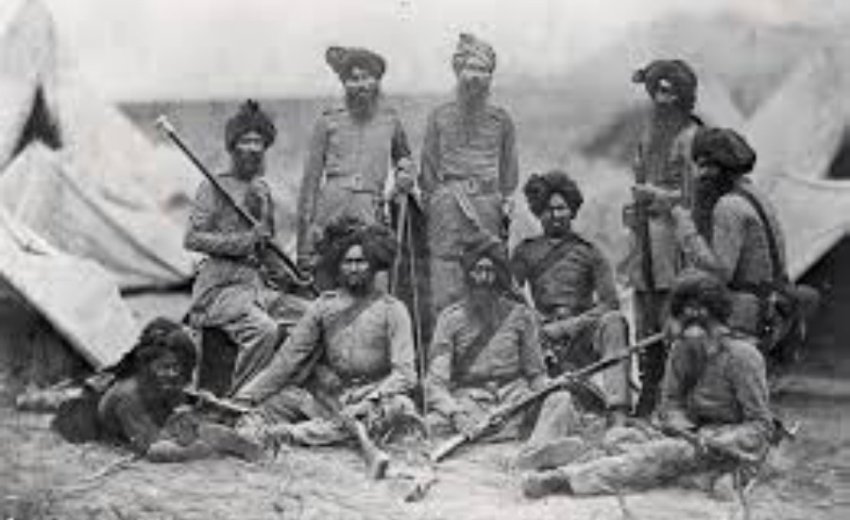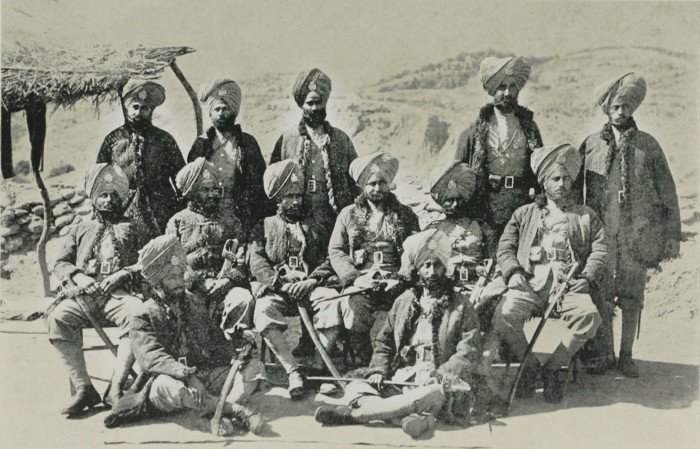Co-written by Harprabhjeet Singh Bedi‘
Saloks’ were chanted from the ‘‘Granth Sahib’’ by the Granthi of the 36th Sikhs in a sonorous voice that penetrated to and excited all the Sikhs listeners and in the end Bhai Takht Singh Ji offered up the following prayer in the vernacular :-‘ May all the Sikhs ever flourish under benign rule of the British Government. May we all remain ever true to the salt we eat. May we find our greatest pride in emulating the heroism of the men of Saragarhi and should our own time come may we all be equally ready to lay down our lives.
"When the hour of mortality of this body arrives, I should die fighting on the battle field with unbounded courage"~ (Swaiyya) Guru Gobind Singh Ji’’.
‘Their bodies were lying about, and there was a most unpleasant smell. The fort is all in ruins, and the rocks which surround it are covered with bullets. Some of their khaki coats were lying about, charred and covered with blood. It was there that the whole garrison of twenty one Sikhs were cut up, and some of them burnt half alive. ‘No other relics were found and even the iron bracelets invariably worn by the Sikhs were missing’ from which it is evident that the bodies must have been completely stripped before the walls were pulled down upon them by the enemy’! No one will know how an entrance was forced, but saw a large breach in one corner, and presumed that the Afridis crept up that, under which they would have been covered from fire, and picked out the masonry. The bodies were brought back to the camp and cremated in accordance with the rites of Sikh religion. We each brought back bullet as a memento, though I think shall never forget what we saw’. ~ Commander: 2nd Division, Kohat Field Force, Major General Arthur Godolphin Yeatman Biggs.
NATIVE OFFICERS OF THE 36TH SIKHS. TIRAH, 1897.
The magnificent stand of the handful of the 36th Sikhs, who perished in Saragarhi, will rank with the noblest deeds of arms, thus proving their loyalty and devotion to their Sovereign the Queen Empress of India, and gloriously maintaining the reputation of the Sikhs for unflinching courage on the field of battle.
The gallant 21 Sikhs stood their ground in obeisance to Guru Gobind Singh's hymn (Swaiyya) that "When the hour of mortality of this body arrives, I should die fighting on the battle field with unbounded courage"
The ruins of Saragarhi Post
The shattered doorways, the dismantled parapets and the broken walls, all formed a silent monument.
The ridge of Samana overlooks the Orakzai territory. On its summit lie two forts Gulistan and Lockhart, a third smaller post, called Saragarhi, being situated between these two. The function of the latter is chiefly to maintain signalling communication between the two larger forts.
On September 10th information was received that a large force of Afridis and Orakzais was on the move and intended cutting into British territory between Hangu and Kohat. Major General Yeatman Biggs at once moved out to the Samana ridge and succeeded in driving back the enemy returning on the 11th to Hangu. The enemy foiled in their attempt to raid British territory now turned their attention to the forts on the ridge and at about 10 A.M. on the morning of September 12th, 1897 bore down in overwhelming strength on the small post of Saragarhi.
The little garrison of the 21 Sikhs had to choose between surrender and death. With true Sikh gallantry they unhesitatingly choose the latter, even after they saw that the defective construction of the work they occupied rendered defence impossible.
The post was not capable for a prolonged defence owing to weakness in construction, situation and strength, and the enemy was looking for an easy victory. But it was not to be so. The defenders repulsed repeated attacks, with victory nowhere in sight for the attackers who suffered heavy casualties. The tribal chief, Gul Badshah tried to allure the defenders to surrender but Havildar Ishar Singh replied that Sikhs never surrender, and the biggest sin would be to surrender and not to fight to their death, thus upholding the religious beliefs, tradition and greatest honour of Sikh religion and after failing, put in another attack.
Two furious assaults were beaten off by the gallant defenders but during the third, two of the enemy found themselves under the walls of the fort in a dead angle completely screened from the defenders fire. They quickly succeeded in making a breech, and another attack was at once forced home, the enemy rushing in by hundreds. The gallant twenty one were obliged to leave their posts on the wall to meet the rush of the enemy at the breech whereupon the attackers scaled the walls and were soon inside the post. Beaten back by the enemy now swarming on every side, the small garrison yielded only inch by inch, fighting gallantly. It was a grim scene in a grim theatre. The end must come sooner or later, but until such time the Martinis of the Sikhs cracked out defiance and death to the enemy.
"The enemies are in. Shall I go on signalling or shall I take the rifle?" He dismounted his heliograph equipment, carefully packed it in a leather bag , fixed bayonet on his rifle and joined the fight, after all had gone never to return.~ Gurmukh Singh
Now the fate of the gallant Sikhs at Saragarhi was certain. It was only a matter of time. The door was attacked, and the garrison slowly but surely was reduced by the enemy’s marksmen. For six and half hours these heroes fought their great fight, and held their own until it become impossible with the few unwounded men left to arm both the walls and guard the entrance door.
And so, man by man, fighting grimly and silently to the last fell every one of the twenty one heroes who defended Fort Saragarhi against the Queen's enemies. The signaller, faithful to the last, remained coolly sending messages to Fort Lockhart till he was cut down by the enemy when the fort fell at 4.30pm. Precisely, what happened will never be known, for not a man escaped to tell the tale. The very meagre account of the defence and fall of Saragarhi is supplied by the signaller at Saragarhi who kept in communications to the last, and by the on lookers at Fort Lockhart and Gulistan who, powerless to render assistance, witnessed the grim tragedy to its sad finale.
Tales also came from the enemy corroborating the battle in the guardroom. And how one wounded Sikh who lay on his charpoy when the Afridis surged in to the serai shot down four men before his death blow came. According to the other reports given by the attackers, one Sikh retired into the inner quarters, and, not withstanding repeated summonses to surrender, he plied his rifle with such effect that twenty of his attackers fell before he finally succumbed to the flames in which the post was enveloped. Such valorous deeds need no eulogy.
‘‘21 men of mine fought like demons. One brave fellow held out in the guard room, and killed 20 of the enemy. He could not be conquered, and at last was burned at his post. These men died the death of heroes, and though the annals of the native army of India are full of brave deeds. These men gave up their lives in devotion to their duty.”- Major Des Voeux 36th Sikh Regiment.
The following is an extract from a letter received by Lieutenant Colonel Webb from Lieut. Davidson. Dated Malakand, the 21st October 1897: —
“At Saragarhi, which is between Fort Lockhart and Fort Gulistan, a few weeks ago the garrison of 21 men of the 36th Sikhs were all killed, but only after a splendid defence. As the men were killed the survivors broke the rifles of those that fell, and thus only eight or nine rifles fell into the enemy's hands. For devotion to the salt this is hard to beat."
‘‘In all the annals of European warfare we do not believe a more heroic act that performed by the Sikh sepoy in the guardroom at Saragarhi has ever been chronicled’’~ General Sir Bindon Blood
OFFICERS OF THE 36TH SIKHS, TIRAH , 1897.
Sitting from L-R. Lieut. Munn , Capt. Custance , Capt. Prall I.M.S. , Col. Haughton ,
Lieut. Turing , Major Des Voeux , Capt Searle. Standing L-R. Lieut. Craster ,
Lieut. Browne, 2nd Lieut. Van Someren.
At 12 noon on the 14th the Saragarhi heights had been taken by General Yeatman Biggs and by 1 pm a great retreat of the enemy began. When General Yeatman Biggs relief force reached the dismantled Saragarhi post, it was a piteous sight. The little post was levelled almost to the ground and amid the ruins of the fort they had so gallantly defended lay the stripped and horribly mutilated bodies of the little garrison. It is impossible to describe the nature of the mutilation which these wild Pathans inflict on their helpless enemies - It is revolting in the extreme. As corpse after corpse, maimed and disfigured, was drawn forth the comrades of the dead men looked on in terrible silence.
The enemy who attacked Saragarhi were the Mamuzais, Ali Khels and Ali Sherzais, together with the Afridi lashkar.
Negotiations for peace were then begun with the Afridis in November at Bagh, to comply with the terms offered to them who under the threat of another expedition into Tirah in the spring at length, agreed to pay the fines and to surrender the rifles demanded. General Lockhart informed them of the terms which would be granted. The Ali Khel Orakzais was paying the fine imposed upon them.
Among the rifles which they brought in were six Martinis captured from the 36th Sikhs at Saragarhi. The fore ends of these weapons were shattered by bullets, showing how serve was the action fought there.
According to General Kempster’s detached brigade camp at Ziya-ud-din Zakka Khel territory, it is interesting to note that during the advance to Saran sar, a Sikh quoit was found in a mosque. It had been broken into four, and was smeared with blood. Another tragic memento of Saragarhi!
What can be finer than the story of Saragarhi, where twenty one Sikhs preferred death to dishonour?
Below are the details of the famous twenty one Sikhs of the 36th Bengal Infantry, who held the post of Sara garhi on 12th September 1897.The twenty one were thus distributed ; fourteen of D company, six of H Company, one of A Company.
The first table of details is provided by Brigadier General Kanwaljit Singh Ji (Retd.) of 4th Sikh based on his research and the second table is from the source of the Indian Heroes Fund England, Tirah Campaign dated 5th May 1898.
In memory of Saragarhi.
Saragarhi Memorial Gurdwara
The ‘Snow White’ Sikh Temple design was prepared by
Bhai Ram Singh Ji, vice principal of the Lahore School of Art.
Saragarhi Memorial Gurdwara has been erected in the cantonment at Ferozepur to commemorate the gallant defence of fort Saragarhi by the party of the 36th Sikh regiment who fell in the heroic defence of Fort Saragarhi on September 12, 1897. The Gurdwara was inaugurated by the Lieutenant Governor of Punjab, Sir Charles Montgomery Rivaz in 1904.
In the course of his speech, The Lieutenant Governor said: -
‘The heroic defence of Saragarhi is a notable proof of the still living vigour of Sikhism and of the undaunted courage of the Sikh Soldier. Happy is the country that can breed such men as those who fought and died on the memorable day, and happy too, yes thrice happy, is the nation which can command the willing and loyal services of such men, faithful even unto death’.
The Lieutenant Governor of Punjab, Sir Charles Montgomery Rivaz then pulled the cord of the curtain covering the main door of the memorial, and in a loud voice declared the building open. A curious thrill in the Sikh crowd at this juncture drew attention suddenly away from the platform to the triumphal arch through which was now seen to appear a solemn procession of Gurus carrying and escorting the ‘‘Granth Sahib,’’ or sacred scripture of the Sikhs, to its shrine or altar in the temple. Already the procession had encompassed the native city, and its march is now ended the holy book was borne into the temple, placed on its proper repository, opened with due form and read. ‘Saloks’ were chanted from the ‘‘Granth Sahib (Sikh Holy Scripture)’’ by the Granthi (Priest) of the 36th Sikhs in a sonorous voice that penetrated to and excited all the Sikhs listeners and in the end Bhai Takht Singh offered up the following prayer in the vernacular :-
‘May all the Sikhs ever flourish under benign rule of the British Government. May we all remain ever true to the salt we eat. May we find our greatest pride in emulating the heroism of the men of Saragarhi; and should our own time come may we all be equally ready to lay down our lives in loyal service for the great Sirkar under whose protection we live in happiness.
Major General Arthur Godolphin Yeatman Biggs, C.B., the son of Mr. Harry Farr Yeatman, of Stock House, Dorset and Emma Biggs, the only daughter of Mr. Harry Biggs, of Stockton House, Wiltshire. He was born in 2nd March 1843, and after choosing the Bar as his profession, finally decided to enter the Royal Artillery, which he did at the age of seventeen, and was for the moment, the youngest officer in the Army. The record of General Yeatman Biggs' services covers a period of thirty seven years, during which he was employed in the following campaigns and military expeditions - The operations against the Taping rebels in China, 1862. After a little service in China, where he was slightly wounded at the taking of the Taku forts he rose to be Captain in 1874, Major in 1881, and Colonel in 1886, and was made C.B. in 1891. On the staffs of Lord Roberts and Lord Wolseley, he served with distinction in South Africa in 1870, in Egypt in 1882, India in 1894, as assistant Adjutant General, and then in command of the capture of Dargai .In 1897, commanding the 2nd Division of the Tirah (Kurram Kohat) Expeditionary Force. Major General Arthur Godolphin Yeatman Biggs, C.B. - died on 4th January 1898. He died of exhaustion (dysentery) at the age of 54. He is buried at Tehkal Cemetery, Peshawar. Major General was lamented as an accomplished gentleman, a gallant soldier, and a good friend, by everyone who knew him.
Acknowledgements.
I am thankful to Brigadier General (Retd) Kanwaljit Singh Ji of 4th Sikh , Centre for Armed Forces Historical Research United Service Institution of India Sqn. Leader (Retd) Sdr. Rana T.S Chhina, MBE, Mr. Huyshe Yeatman Biggs and Family and Mr. Graham Davies.
Resources: ~
i) Brigadier General Kanwaljit Singh Ji (Retd.) of 4th Sikh.
ii) Mr. Graham Davies.
iii) The Indian frontier war, being an account of the Mohmund and Tirah expeditions, 1897.By James, Lionel, 1871-1955
iv) Saragarhi will live forever in the golden pages of Sikh History. http://www.panthic.org/articles/5292
v) The Pathan revolt in north-west India by Mills, H. Woosnam
vi) Lieutenant Colonel John Haughton, commandant of the 36th Sikhs: A hero of Tirah. A memoir by Major A.C. Yate 1900 Archive.org
vii) Officers of the 36th Sikhs, Tirah 1897 ~Vosts Images.
viii) The ruins of Saragarhi Post ~Royal Geographical Society
ix) British Library










